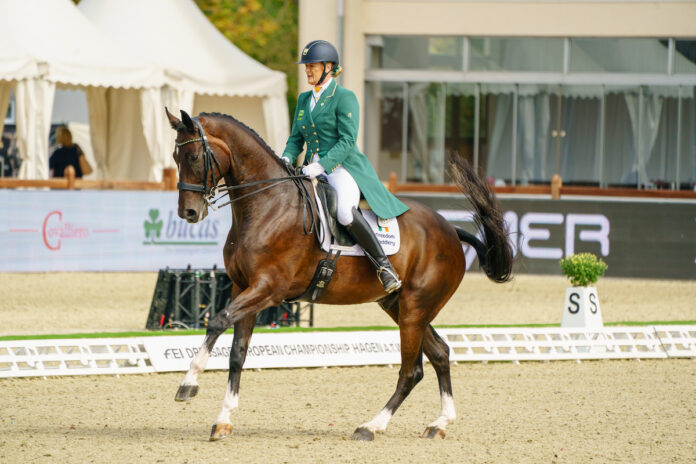Girthing: is it as important as saddle fit?
By Steph Bradley – SMS Reg Master Saddle Fitter and Dip. M.S.F.C.
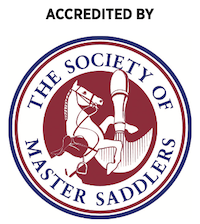
Saddle fitters who read the feature and submit correct answers to the quiz via www.equestriantradenews.com will be awarded CPD accreditation by the Society of Master Saddlers (SMS). SMS Registered Qualified Saddle Fitters are required to maintain CPD fulfilment as part of their registration. Successful completion is worth 30 minutes’ training time.
Good saddle fitting will include a practiced and routine protocol assessing horse conformation.
It should assess the fit of the saddle both statically and dynamically, as the horse in flexion will lift the abdomen and raise the thoracolumbar and lumbosacral regions (Denoix and Pailloux, 2001; Payne et al. 2004; Colbourne et al., 2008).
The abdominal anatomy and physiology of the horse will influence the dynamic fit of the saddle. Therefore, it is equally as important for saddle fitters to have an understanding of this part of the equine anatomy and its influences.
Common signs caused by girth pain are generally similar to those with an ill-fitting saddle - facial expression suggesting pain or anger, biting, blowing out to protect the ribs, bucking, hyperflexing the back on saddling, tail swishing, ears back, shortened stride and other general behaviours that suggest discomfort.
Extreme signs could be Episodic Collapse in the horse (Lyle and Keen, EVE 2010) where the horse has a form of narcolepsy initiated by a neural reflex causing the horse to effectively pass out – the cause being the association with being saddled. This is extremely rare, but something every saddle fitter should be aware of.
BASIC GIRTH FITTING
Most qualified saddle fitters will be aware from their training as to the individual position of the girth groove, and the influence and position of the girth strap on the saddle reading optimal dynamic fit.
A good example being of a monoflap saddle with fixed girth straps attached as part of the flap, with no ability to articulate into the individual horse’s girth groove without the saddle moving accordingly. This issue can cause major issues of saddle slip forwards or backwards if the two are not aligned – and have a detrimental effect on performance.
I have witnessed this with an international grand prix dressage horse where the fixed strap saddle moved slightly forwards during the test and restricted the shoulders, causing low marks in the transition from extended trot to collected trot. The discomfort was translated into a hollow and stilted forelimb movement, almost ‘pottery’ in the downwards transition, and a lack of freedom in the extension.
Statically, the saddle appeared a good fit – until the position of the girth strap’s lack of alignment with the girth groove was noted. A change of saddle and more suitable girthing by way of girth straps, and the horse moved very differently.
There are many different shapes, attachments and materials within the designs of girth in the market place with a variety of assertions within the marketing material. And there is a wide variety of ‘research’ done – from published papers through to evidence-based anecdote.
The conformation of the horse - position of forelimb, size of thoracic sling and musculature in the girth area, the most caudal position of the scapula cartilage – and, directly linked to this, the girth groove - all need to be taken carefully into consideration.
As part of every saddle fitting, SMS protocols insist on assessing the saddle and girth area particularly for infectious diseases – but also for sarcoids and sores. It is recommended to palpate the girth area and observe the horse for any reaction – taking great care as some horses are prone to negative reaction to this if there is an issue.
Some horses have a great deal of loose skin in the girth area, and this can be causal to not only girthing issues but also clipping injuries during winter months which can interfere also with their comfort levels under saddle.
ANATOMY / PHYSIOLOGY / PATHOLOGY
As saddle fitters, knowledge of back anatomy, physiology and pathology is of great importance. However, we also now know that pressure on key parts of the girth area has influence on the amount of forelimb (tarsal) and hindlimb (carpal) flexion and protraction (Murray et al, Veterinary Journal 2013).
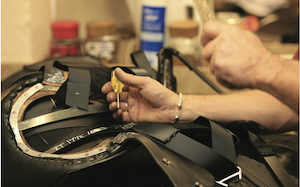
Therefore, a knowledge and understanding of these key areas is essential to ensuring comfort and welfare in the ridden horse as they will develop compensatory gait strategies to counter any discomfort caused in every stride they take.
There is also research conducted by Clayton et al (J Vet Sci 2012 32 519-524) concerning the equine m subcutaneous trunci and how the position of the saddle and girth play a role in sensitivity to girth pressure, for those wanting to further develop knowledge in this area.
Key muscle groups that are directly affected by girthing are the pectoral muscle, which runs from the neck through the legs and to either side of the sternum, and the serratus ventralis thoracis (SVT) which sits over the ribs and directly where a girth and girth straps are placed.
Indirectly, the intercostalis, external abdominal oblique and rectus abdominus are impacted.
I have observed a horse which could tolerate a long girth jump saddle but was incredibly resistant in a monoflap jump saddle.
The only difference was the position of the buckles of the girth. The behaviour of the horse was poles apart – and I referred the horse for veterinary assessment as I had concern that the horse may have injured ribs. It had already been scoped for ulcers due to behavioural issues on girthing and saddling.
Girth buckle position and height is an often-queried subject with clients. As a general rule, positioning the girth buckles as high as possible to avoid interfering behind the elbow is the most comfortable for the horse and the impact it can have on performance should always be kept in mind.
Fascia and nerves are also key to girthing. The brachial plexus cluster of nerves are located exactly under the area where the girth will go, linked and given stability by the fascia (or inner skin) through which they are interlocked. The fascia in this area influences cranially to the shoulder and elbow joints and caudally to the stifle (Clayton et al, 2012).
Because of the intense concentration of nerves and the interlinking of the fascia, it is easy to see why the girth area is an incredibly sensitive area and how girthing can influence the horse’s movement both positively and negatively.
Damage to the m. cutaneous trunci beneath the saddle and girth (buckle area) is possible from ill-fitting tack and can result in a response indicative of pain on back palpation. Therefore, when palpating the equine back as part of the protocol, saddle fitters should bear this in mind.
So, how does a horse who is in discomfort due to their girth react? No doubt many saddle fitters will have observed skin reaction – a quiver associated with muscle reflex, observed as twitching. The areas under the girth are not accessible to horses to scratch the area that is causing irritation.
This ‘panniculus reflex’ or twitch is an endeavour to rid themselves of the source of the irritation. Therefore, this pathology should be taken seriously when assessing the horse. The difficulty can often be identifying the local point of discomfort as often (given the interlinking of nerves and fascia explained above)
the observed twitching can be observed all across the body. Remember a horse can feel a fly!
Ongoing use of an ill-fitting girth that created this reaction in
a horse will create persistent sensitivity – and can be seen even when the girth has been replaced to one that is comfortable. This is due to the neural pathway to the brain that believes it will be uncomfortable and is why even when saddlery has been adjusted for optimal fitting, negative reaction may continue to be observed.
Therefore, a negative reaction suggesting discomfort on girthing may be due to a number of reasons. These include memory of pain, ulcers, sacro iliac pain, rib pain, skin sores and bruising as some to mention. The more extreme reaction of episodic collapse is also one to remember.
SOLUTIONS
So, what can we do?
The first and most obvious action saddle fitters can take, once the saddle and girth straps are fitting, is to ensure the girth straps are correctly located, the girth is the correct shape and length and not interfering with the elbow.
There is a myriad of girths on the market. If the girth straps are correctly positioned, you may need to find a suitable girth to align with these. Girth straps pulling forward or backwards will influence the saddle.
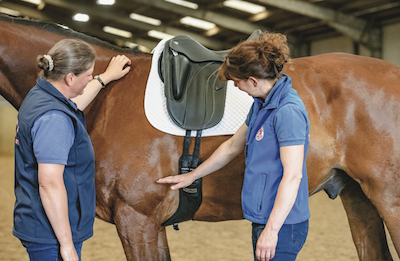
H girths and curved anatomical shaped girths are designs that can sometimes help here. Anatomical girths and shaped girths all have their place. Research (Murray et al, 2013) has told us that the pressure from the girth is found in the area where sores develop – so possibly affecting the m. cutaneous serratus and serratus ventralis if done up tightly enough. The sternum only showed high pressure if a looped martingale or an integral clip is used.
Elasticated girths can cause issues affecting saddle stability – slipping left and right. Elasticity strength deteriorates and there is a tendency to over-tighten with an elastic girth.
Rider ability and imbalance also can cause issues; if the saddle slips, the girth will slip. Riders who have limited pelvic mobility can cause unnecessary trauma to the cutaneous trunci mm and associated structures – which would possibly present as a girth issue. (Hilary Clayton, Feb 2021)
Checking the height of a short (dressage) girth. The buckles are well clear of the elbow. The girth should end close to the saddle pad, without overlapping the edge, which can cause focal pressure
I also quite often witness girths that are incredibly hard with sharp edges. Maybe this is by design - ‘value’ brands with cost- effective material being used. But some ‘value’ brands kept clean and looked after are often more comfortable than expensive ones! Or simply years of sweat and grime that have made the leather hard.
Remembering the concentration of nerve endings in this area discussed above, is it any wonder? How do riders feel in hard, uncomfortable boots or shoes?
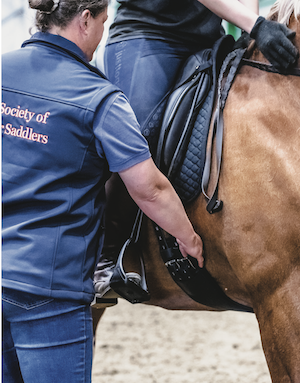
Another issue I have witnessed is when a horse is not clipped and the coat gets stuck in the creases of the girth and literally pulls the hair from this sensitive area. I have observed a thin vertical line of white hair as a direct consequence of the pressure.
How is the girth done up? Is the girth left buckled onto the saddle on one side for speed of tacking up? This should be strongly advised against! As saddle fitters, we must set an example by doing up the girth slowly in this sensitive area. One side then the other, taking time and care not to over-tighten.
Look for girths with cracks on the sides or in the leather on the underside where it has not been cleaned – often only seen on the underside of the girth and pinching the skin to cause discomfort. Obvious but often overlooked. As a saddle fitter, it is important
to look at all saddle-related tack – and running hands over the underside of the girth is a good habit to get into
In summary, assessment of the girth and girthing are an integral part of good saddle fitting. Given the influence the girth has on both the saddle and equine welfare and performance, it is something that must not be overlooked in our quest to ensure optimal wellbeing of the ridden horse.
With thanks to Dr Jane Nixon (SMS Veterinary Adviser) and Dr Russell MacKechnie-Guire for providing background information.










